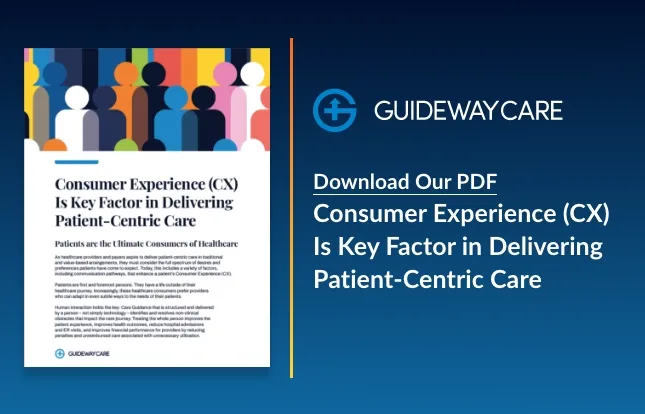This Surge is Different and Harder to Manage – Care Guidance Can Help

With new COVID-19 variants driving up rates of ER and inpatient utilization, hospitals are trying to adjust. Some of the problems are the same: lack of PPE, misinformation, and bed shortages. But this wave has some unique characteristics that make it more challenging.
The availability of the vaccine and the behavior of the delta variant are dominating headlines. What is less prominent is the trend toward sicker and more complex non-COVID patients. After months of quarantine, many patients delayed or deferred care. As a result, non-COVID patients come into the hospital at a higher acuity and require more resources, including more extended inpatient stays. This is adding to provider burnout and exhaustion, which has reached unprecedented levels.
Non-clinical care guidance is a cost-effective and scalable solution to help intervene and divert high-risk patients before they enter the ER. Through outreach to high-risk patients, care guides can help reduce avoidable ER and inpatient utilization rates, lower demands on clinical staff, and help relieve resource constraints. They do this by helping divert patients to better care sites, addressing patient non-compliance, intervening on rising risk patients before they have an adverse event, and monitoring and managing patients for depression and anxiety.
Diverting Patients to Better Care Setting
Often, patients can be better served within an urgent care setting. And these urgent care sites are typically closer in proximity and have shorter wait times. But a lack of awareness drives patients to choose the ER over an urgent care center. They may not know that urgent care is an option or an urgent care center’s services.
Care guides can fill the gap in patient education by making sure that patients know about urgent care options and when they are available. They can do this over the phone, through email, or even text message. And education can happen before or after an ER visit. Care guides can proactively connect with high-risk patients to make sure they understand urgent care options and when to use them. For patients recently discharged from the hospital, care guides can send communications promoting the closest urgent care center and include wayfinding information and hours of operation.
Addressing Patient Non-compliance
Socioeconomic determinants and barriers to care drive up avoidable utilization by creating care gaps that lead to deterioration and ER utilization. Lack of transportation, financial challenges that impede medication adherence, misuse of remote patient monitoring devices—these are all non-clinical challenges that can quickly drive a high-risk patient into the ER.
Care guides can help address the non-clinical barriers that increase risk by lowering non-clinical obstacles and connecting patients to community resources. Finding a funding source or community grant that can help a patient fill a prescription or walking a patient through the set-up of a remote glucose monitoring device takes time and multiple touches. Nursing staff are already overstretched, and the second COVID surge is adding to shortages. Care guides can quickly and cost-effectively provide patient outreach, help engage community resources, and do the follow-up needed to ensure patient compliance, adherence, and satisfaction.
Intervening on Rising Risk Patients
Sometimes the right outreach made at the right time is all it takes to keep a patient out of the hospital. Care guides can serve as the front line for nursing staff. They can help monitor patient risk and escalate to clinical staff based on a provider’s protocols. For example, care guides can track the number of pillows that a CHF patient sleeps with every night. When the number jumps to three or four, the care guide knows to escalate the patient to a nurse because the patient is likely struggling to breathe comfortably at night. This ability to monitor high-risk patients for signs of deterioration helps drive intervention earlier and into outpatient settings. It also alleviates cognitive demands on clinical staff by escalating with just the information needed at just the right time to make a care decision.
Monitoring Behavioral Health Needs
COVID has created a behavioral health crisis that is more pronounced for those who are already struggling with chronic conditions. Social isolation from family and friends has caused rates of depression and anxiety to skyrocket. And for many patients, talking about behavioral health needs is difficult.
Care guides create a unique connection with patients. Unlike a clinician, care guides are peers. Patients are more likely to share needs, fears, and concerns with a care guide because of the peer-patient relationship. And through tools like the Patient Health Questionnaire (PHQ), care guides can monitor patients for depression and anxiety and escalate to a clinician when needed.
COVID-19 will have lasting and unforeseen impacts on our healthcare system. As we learn to adapt, ensuring quality, sustaining healthcare resources, lowering staff burnout, and improving overall satisfaction will remain focal points. Non-clinical care guidance is a scalable, cost-effective, and proven path to closing many of the gaps and risks that lead to avoidable utilization. It is an approach predicated on prevention, connection, and early intervention so that patients are cared for before they deteriorate, and clinicians are supported so they can continue to help those most in need.
Contact Us Today To Learn How We Can Help
"*" indicates required fields




